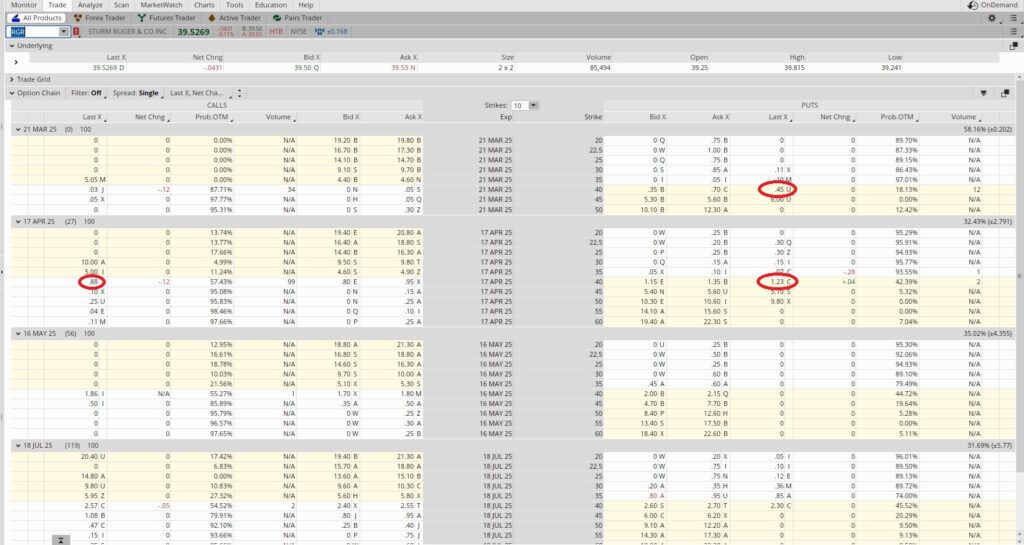Simple Options Strategy
Lately we’ve been selling a straddle for income as a simple options strategy for cash flow. We’ve been using RGR as our company, and we currently have 200 shares of RGR in this portfolio. So far we’ve worked our basis down to $32.69 per share. Today is 3/21 and we have a covered call at the $40 strike that will expire worthless out of the money today. We also have a cash secured put at the $40. With RGR trading below $40 we will be put shares on the put option if we don’t adjust the position. RGR does not have a dividend any time soon so we’re going to adjust the position.
Last time we sold to open the $40 put for $1.25. Here’s a link to the post that walks through that trade. Now we’re going to buy to close that contract and sell to open a new one. We bought to close the cash secured put option for $0.45. Since we brought in $1.25 in passive income when we sold to open the contract we’re netting $0.80 by closing the position. That makes our last trade profitable and frees up the capital. That puts us in a flexible position for our next options trade.
Today we sold to open the $40 cash secured put option contract on RGR for the 4/17 expiration date. We brought in $1.23 with that simple options strategy. Before we commit our capital to a trade we want to be sure we’re generating an acceptable rate of return.
Here’s how we do that math: We take the premium for selling the put and divide that into the strike price. Then we multiply that by the number of times in a year that we could do that trade, or a similar trade on a different company. So in this case it looks like this: $1.23 in premium divided into the $40 strike gives us 0.031. This trade last for one month, and there are twelve months in a year, so our time multiplier is 12. So we multiply the 0.031 by 12 and we get 0.369. That’s an annualized rate of return of 36.9% on the capital we’re risking on the cash secured put option contract.
We like our rate of return to be at least 20% when we use this simple options strategy. This trade checks that box. Here’s the options calculator we use to help determine the annualized return.

We’re also going to sell another covered call. Since we own 200 shares in this portfolio we’re only going to sell one contract. One contract is for 100 shares, so if RGR runs up through our strike we’ll sell 100 shares. That will leave us with 100 shares to hang on to while we wait for RGR to trade where it was last year. We sold to open the $40 covered call option contract for the 4/17 expiration date for $0.88. Between the cash secured put option and the covered call option contract we brought in $2.11 in passive income.
Simple Options Strategy Recap
We’re using options contracts to reduce the basis of the shares we own and generate cash flow. If we end up buying more shares or selling shares at $40 we’re ok with it. Our primary objective with these trades is to bring in the options premium. We sold to open the $40 cash secured put option contract and the $40 covered call option contract on RGR. Both contracts are for the 4/17 expiration date. The put gave us $1.23 in passive income and the call gave us another $0.88 per share in passive income. The two trades together with this simple options strategy bring our basis on RGR down to $31.86 per share.

